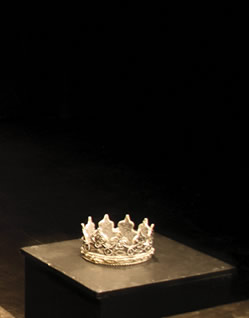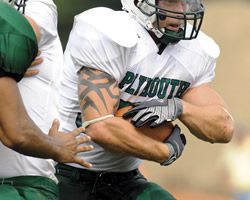The Crew
Assembling the Team
![]() Explore more of Hamlet.
Explore more of Hamlet.
Take a closer look at the costume sketches.
Unlike the actors, the members of the production team were spared the audition process. Director Chuck Vicinus, an adjunct faculty member in the Department of Music, Theatre, and Dance, recalls the impromptu exchange with his colleague Beth Cox that led to his involvement in the production: “I was walking down the hall one day last spring when Beth stopped me and said, ‘Hey, would you like to direct Hamlet?’”
For Vicinus, who has directed several Shakespearean productions including Hamlet, the idea of directing an eclectic cast of students, faculty, alumni, and community members with a broad range of acting experience was intriguing. “I felt that everyone could learn something from everyone else,” he says. “And that’s exactly what happened.”
Early on, Vicinus knew he wanted to make the play accessible to a broad audience, particularly students. “I wanted people to say ‘Wow, Shakespeare’s not all that bad,’” he says. “I didn’t want it to be all doom and gloom. I’ve seen productions like that, and it just doesn’t appeal to an audience.”
Inspired by her positive experience as stage manager for PSU’s production of the Lanford Wilson drama The Fifth of July last spring, Heather Beaulieu ’09 eagerly signed on to be stage manager for Hamlet. “I learned so much and was able to be part of every step in the process, from auditions to striking [breaking down] the set after the final performance,” says Beaulieu, a theatre history and literature major. “And I’ve always loved Hamlet, so it was an easy decision to make.”
As stage manager, Beaulieu was charged with organizing rehearsals, keeping detailed notes on the performers’ positions on stage, prompting the actors during rehearsals, serving as the primary contact for the director, actors, and crew, running weekly production meetings with the director and the crew, and more. During performances, it was her job to ensure the entire production ran smoothly. “On opening night, that’s when the director takes a step back and the stage manager takes over,” she says. “For me, it’s more exciting than being onstage.”
The role of dramaturge, with its emphasis on painstaking research, may seem less than exciting in comparison to the role of stage manager, but the nature of the work held great appeal to Nicole Ramburg-Pihl ’09. An environmental biology major with a longtime passion for theatre, Ramburg-Pihl researched answers to questions that came up during the production. When Vicinus, her Theatre Experience instructor, approached her about being the dramaturge for Hamlet toward the end of last spring, Ramburg-Pihl didn’t hesitate. “It interested me because I enjoy research and finding how things fit together,” she says.
Although much of Ramburg-Pihl’s work was done over the summer, before rehearsals began, she was on call during the rehearsal period to research questions that came up. Using online historical databases, Ramburg-Pihl researched everything from how Elizabethan theatres staged Ophelia’s interment to historically accurate foods and games to the exact way subjects bowed to royalty. Her biggest research challenge? “It took a lot of work to find out about how King Hamlet’s ghost was staged in Elizabethan times,” she recalls. “I’d read an abstract that would seem promising, but then the article itself wouldn’t have anything I could use.”
Despite the occasional dead end, Ramburg-Pihl enjoyed her detective work. “It was a challenge, but I found all of it incredibly interesting,” she says.
Research was also key to Costume Shop Manager Danée Grillo’s work in designing and creating the costumes for Hamlet. “With any show [I’m working on], the first thing I do is skim the script,” she says. “I need to know what’s happening when. Then I pursue the director to find out what he or she is picturing: colors, style, time period … Then I start my research—it’s all about research.”
For her research, Grillo relies upon her extensive library of costuming books. “After I start getting ideas together, the designers, the tech crew, the director, and I have a production meeting where we figure out how my ideas for costumes work with the scenic designer’s thoughts for scenery, the lighting designer’s vision for lighting, and the director’s vision,” she explains.
Once a working design for each character has been established, Grillo submits sketches to the director for final approval. “For Hamlet, we had a strict black, white, and gray palette—very conceptual—which was challenging and fun for me as a designer,” Grillo notes.
While the Costume Shop in the Silver Center houses hundreds of costumes from productions past, Grillo and her students had to “build” (sew) just about everything for Hamlet from scratch, right down to the crowns, hats, wigs, and shoes. “We started about two weeks before the semester began, and continued right up to dress rehearsals,” she says.
Bob Bruemmer ’85, technical operations supervisor for the Silver Center, served as technical director for Hamlet. Among his duties were to work with the scenic coordinator, props master, and sound and lighting technicians to ensure that the produc-tion’s technical needs were met. Like Vicinus, Bruemmer stepped back once performances began. “Then it was the stage manager’s show,” he says. “Heather’s very accomplished and very organized, so it was easy to do that handoff.”
In addition to his technical director duties, Bruemmer ran the scenery shop, as he does for most productions in the Silver Center. “Since it was the first show of the semester, we designed a simple set,” Bruemmer explains. “For us, it was a chance to do very simple pieces with a strong attention to detail.”
Bruemmer’s colleague, Jason Hibbard ’01, technical production assistant at the Silver Center, was the lighting designer for Hamlet. Hibbard’s challenge was creating mood and atmosphere while adhering to the production’s black, white, and gray color scheme. “The challenge was to make the light interesting without any kind of color,” says Hibbard. “So I made steep angles and used a lot of back light and gobos [circular plates with templates or patterns cut into them that, when placed in a light, create patterns of projected light].”’











